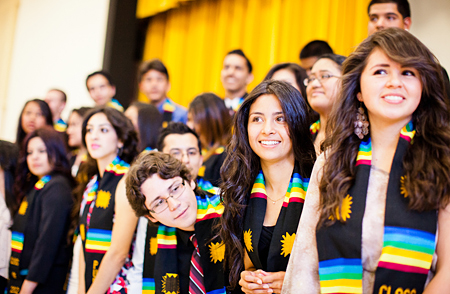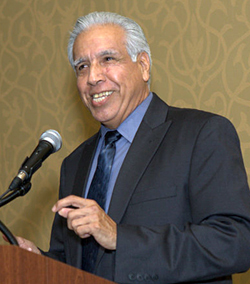Puente Project, long a campus friend, finds a new home at Berkeley
Like old friends who end up getting married, the 30-year-old college-access-building Puente Project has become a part of UC Berkeley’s Center for Educational Partnerships. The move enhances the synergy of both entities, which work to help underserved students succeed in four-year colleges and universities.

September 26, 2012
Like old friends who end up getting married, the 30-year-old college-access-building Puente Project has become a part of UC Berkeley’s Center for Educational Partnerships.
“Everyone here at CEP, myself included, is very excited about the fact that Puente is here,” says Marsha Jaeger, executive director of CEP, which houses 10 other programs that share Puente’s goal: helping more students from low-income and underrepresented communities get into, and graduate from, four-year colleges and universities.

Puente Project students celebrate their graduation from Hayward High School last spring.
“Puente is a highly successful program,” Jaeger adds. “To be able to add Puente to the portfolio of programs here at Berkeley that address college-access issues is going to have a very powerful effect on our overall impact.”
The Puente Project works in 35 high schools and 61 community colleges across California to weave intensive writing, academic, mentoring and counseling efforts into their curricula and teaching, with the aim of engaging students in what they need to do to become college students, graduate and go back into their communities as leaders for future generations, says Frank Garcia, Puente’s executive director.
Moving vans pulled up last week outside CEP’s Kittredge Street offices, just across from campus, delivering the contents of Puente’s statewide office from their old home in the UC Office of the President in Oakland.
The move represents much more than a location change, though. It’s a move from a corporate office suite to a campus environment, Garcia says. “We wanted to be near students.“
While Puente has worked with Berkeley for years, being a part of the campus will allow the organization to deepen its connections with the Graduate School of Education and its faculty, Garcia says. Berkeley’s status as the nation’s top public university adds a shine too, he adds. Puente found deep resonance between its own approach and the strategic goals of Berkeley’s Division of Equity, Inclusion and Diversity, which houses CEP.
“Everyone’s focused on the synergy,” says Jane Allsopp, director of Puente’s high school programs and teacher training.
“At Berkeley, we expect to have greater access to organizations, professors, departments and students who can help bring the right message, the right curriculum, the right standards to our teachers and counselors through our training,” she adds.

Frank Garcia, Puente Project executive director
Being part of the campus will let Puente staffers audit classes and find strong presenters, she elaborates; for example, “I can imagine us going to listen to a Latino studies professor and approaching him afterward about talking to our teachers and counselors.”
It’s a boon to the campus too, according to both Puente and CEP. “Puente will greatly add to Cal’s portfolio of services to the community,” says Allsopp.
CEP’s programs take varied approaches in working with schools and communities to improve college access for students who face significant barriers to higher education. Altogether, the programs work with more than 48,000 high school and community college students statewide each year.
Along with other campus efforts, CEP programs have helped reverse the precipitous drop in the admission of underrepresented students to UC, especially its most selective campuses, that followed the passage of Proposition 209 in 1996, Jaeger says. The measure outlawed affirmative action in public university admissions.
However, progress has been incremental and more remains to be done, she adds: “Having Puente here will do nothing but strengthen our ability to have an impact.”
Puente’s approach is to be fully engaged with the campus community. “We are totally embedded at the schools and colleges where we have programs,” says Allsopp.
Teachers and counselors are trained to incorporate the Puente principles into their classes and advising, Garcia explains — starting with helping students see themselves as college potential.
During high school, students stay with the same Puente-trained teacher for ninth and 10th grades, and with their Puente counselor through graduation. The students visit four-year campuses like Berkeley, and work through leadership and service components, where they become engaged in serving the community. And Puente stays involved even after its students enter a four-year school.
In community colleges, the same ideas are put to work to increase the number of students transferring to four-year schools. “Besides training,” adds Julia Vergara, Puente associate director, “the community college program is continually refining best practices and developing practical interventions.”
The program, open to all underserved minority students, gets results, Garcia says; for instance, about 56 percent of Puente community college students will transfer to a four-year school, compared to 34 percent of educationally disadvantaged students. And in 2010, for example, 78 percent of Puente high school graduates went on to college, compared to 46 percent of graduates statewide, according to figures provided by Puente.